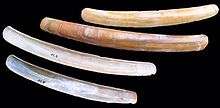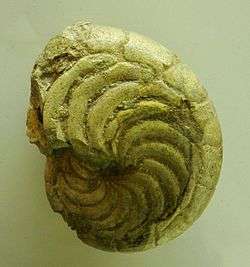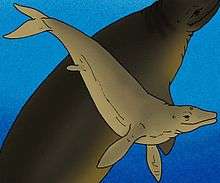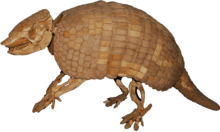Castle Hayne Limestone
| Castle Hayne Limestone Stratigraphic range: Eocene | |
|---|---|
| Type | Formation |
| Location | |
| Region |
|
| Country |
|
The Castle Hayne Limestone is a geologic formation in North Carolina. It preserves fossils dating back to the Paleogene period. It preserves many of North Carolina's renowned Eocene fossils. It is named after the locality of Castle Hayne in New Hanover county, though the formation itself stretches over several counties.
Molluscs
[1]
| Genera | Species | Notes | Images |
|---|---|---|---|
| Chione | C. sp | _(1907)_(14592753318).jpg) | |
| Crassatella | C. wilcoxi
C. sp |
A crassatellid bivalve. | |
| Ensis | E. sp |  | |
| Flemingostrea | F. sp | ||
| Giganostrea | G. trigonalis | An extinct group of oyster. | |
| Glyptoactis | G. sp | ||
| Panopea | P. sp | A close relative of the modern geoduck. | |
| Pecten | P. membranosus | An extinct bivalve that belonged to the same genus as most modern scallops. |  |
| Pholadomya | P. sp | ||
| Plicatula | P. filamentosa | ||
| Venericardia | V. sp |
Cephalopods
| Genera | Species | Notes | Images |
|---|---|---|---|
| Anomalosaepia | A. vernei
A. mariettani A. alleni A. andreane A. sp |
An extinct group of cuttlefish that was also found in Egypt and belonged to the family Anomalosaepiidae. | |
| Aturia | A. alabamensis | Belongs in its own family: the Aturiidae. |  |
| Beloptera | B. sp | Another extinct group of cuttlefish that was found in several localities in Europe. | |
| Conchorhynchus | C. furrus | Has not been classified into any specific cephalopod group yet. | |
| Eutrephoceras | E. carolinensis | First originated during the Cretaceous period. | _-_Strasbourg_specimen.jpg) |
| Rhyncolites | R. sp
R. minimus R. aturensis |
An extinct group of nautiloid that has not yet been classified into any specific family. |
Vertebrates
Mammals
Cetaceans
| Genus | Species | Notes | Images |
|---|---|---|---|
| Zygorhiza | Z. kochii | A close relative of the well-known archaeocete Dorudon. |  |
| Basilotritus | B. wardi | A basilosaurid that was originally classified under Eocetus. |
Sirenians
| Genus | Species | Notes | Images |
|---|---|---|---|
| Protosiren | P. sp | A prehistoric manatee relative that is also known from Eurasia. |
Cingulates
| Genus | Species | Notes | Images |
|---|---|---|---|
| Holmesina | H. sp | A pampathere that resembled a giant armadillo. It arrived to North America after migrating from South America. |  |
Reptiles[2]
Squamates
| Genus | Species | Notes | Images |
|---|---|---|---|
| Palaeophis[3] | P. grandis | An extinct species of giant marine snake from the family Paleophiidae. |
Turtles
| Genus | Species | Notes | Images |
|---|---|---|---|
| Cheloniidae indet | Known by plate, shell, and plastron fragments. |
Crocodilians
| Genus | Species | Notes | Images |
|---|---|---|---|
| Crocodylia indet | Known by vertebra. |
See also
References
- ↑ "Online Collections | North Carolina Museum of Natural Sciences". collections.naturalsciences.org. Retrieved 2016-03-15.
- ↑ "Online Collections | North Carolina Museum of Natural Sciences". collections.naturalsciences.org. Retrieved 2016-03-19.
- ↑ "Fossil ID Quiz" (PDF). JANUS. North Carolina Fossil Club. pp. Name is on Page 5 , Location is listed next to fossil #11 on Page 7.
- Various Contributors to the Paleobiology Database. "Fossilworks: Gateway to the Paleobiology Database". Retrieved 22 June 2014.
| Paleogene Period | ||
|---|---|---|
| Paleocene Epoch | Eocene Epoch | Oligocene Epoch |
| Danian | Selandian Thanetian |
Ypresian | Lutetian Bartonian |Priabonian |
Rupelian | Chattian |
This article is issued from Wikipedia - version of the 3/19/2016. The text is available under the Creative Commons Attribution/Share Alike but additional terms may apply for the media files.